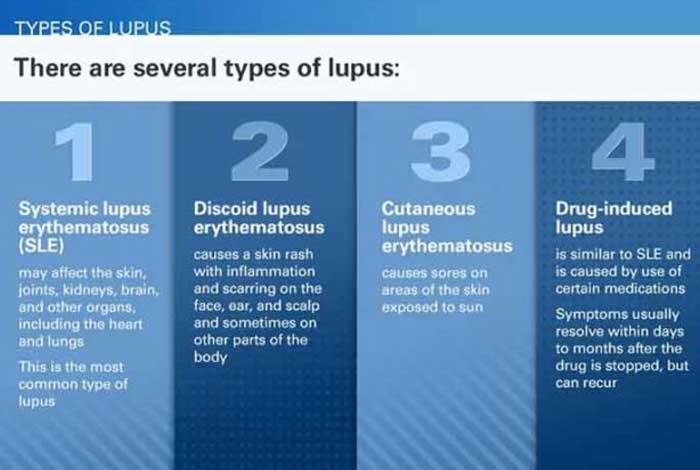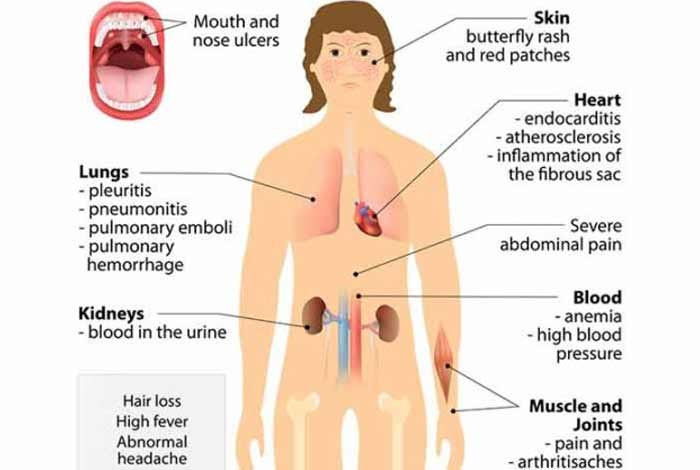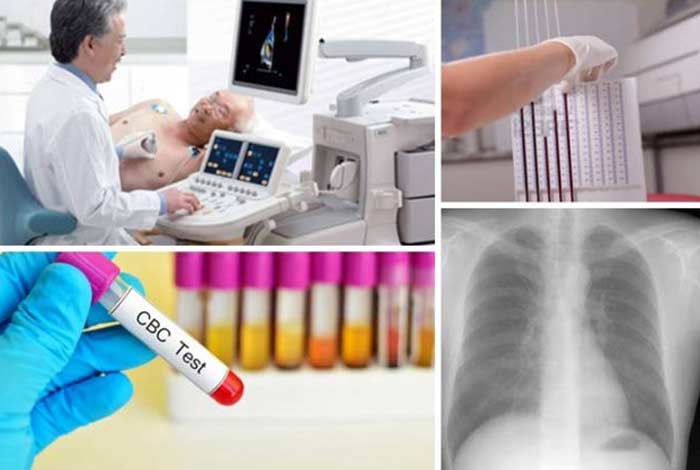
Overview and Statistical Facts of Lupus
The immune system is responsible for protecting our bodies against infection. It does so by identifying foreign cells in the body and producing proteins called antibodies against it. However, in some conditions, the immune system becomes oversensitive and starts attacking body’s own cells, causing auto immune disease. One such disease is lupus in which different body organs become inflamed, like skin, joints, brain, lungs, heart and blood vessels. It is a non-contagious disease whose symptoms vary from one person to other.
This disease is difficult to diagnose because its symptoms are similar to several other diseases. One of the most distinctive feature of lupus is the presence of a facial rash resembling the wings of a butterfly across the patient’s face. This is present in most of the patients but not necessarily in all. Some people are prone to developing lupus than others. Lupus is also thought to run in families. Exposure to sunlight, drugs and infections are also known to trigger lupus. While there is no cure for lupus, its symptoms can be effectively managed with the help of medicines and lifestyle changes.
Lupus is more common in women of child bearing age than in men. Most people develop lupus in the age group of 15-44 years. As per the Lupus Foundation of America, about 5 million people across the globe suffer from one or the other form of lupus, with nearly 1.5 million patients being in the U.S.A. alone. It is estimated that nearly 16,000 new cases of lupus are diagnosed every year. The disease is more common among women of color. It is estimated that lupus affects 1 in every 537 young African American women.

Types and Symptoms of Lupus
Following are the different types of lupus:
Systemic Lupus Erythematosus (SLE)
It is the most common type of lupus that affects skin, blood vessels, joints, brain, lungs and heart. The condition manifests itself with different symptoms for different individuals, varying from mild to severe. One of the most common symptoms of SLE is a butterfly shaped rash on the face of the patient, covering both his cheeks. Remission time is a phase in the SLE when there are no symptoms, referred to as remission period.
Discoid Lupus Erythematosus (DLE)
DLE is a disease in which only the skin which is exposed to sunlight gets affected. However, the internal organs do not display any symptoms and remain unaffected. Areas that get affected with DLE are generally left with a red rash even after the lesions have vanished.
Sub-Acute Cutaneous Lupus
This condition is similar to DLE and affects the skin that gets exposed to sunlight. According to researchers, sub-acute cutaneous lupus is epidermal atrophy in which the upper layer of skin gets affected. After the symptoms subside, no marks or scars are left on the skin. [1]
Drug-Induced Lupus
It is a condition which arises due to consumption of some prescribed drugs like hydralazine and procainamide. These drugs sometimes cause adverse reaction in some people and result in lupus. When the patient stops taking the drugs that are causing the disease, the symptoms go away.
Neonatal Lupus
It is a rare form of lupus that affects newborn babies whose mothers have lupus or any other autoimmune disease. It causes the babies to develop skin rashes, low blood count and liver problems. The symptoms generally go away in a few months after the birth and do not cause any permanent damages. There is a chance that a baby being born with lupus might have a serious heart defect.

Symptoms of Lupus
There are no specific symptoms of condition. They vary from patient to patient, depending on the extent to which the condition affects the immune system. However, some of the common symptoms of lupus are:
- Pain in the joints along with swelling and stiffness
- Fatigue, tiredness, and muscle pain
- Fever without any cause
- Rash on the face, i.e. a big butterfly shaped rash that covers both the cheeks and the nose bridge of the affected person.
- Photosensitive skin, i.e. formation or worsening of skin lesions when exposed to sunlight.
- Finger and toes turning pale or blue during stressful situations or when exposed to cold.
- This is also referred to as Raynaud’s syndrome.
- Shortness of breath and chest pain while trying to take a long breath.
- Headache and confusion.
- Swollen glands
- Dry eyes
- Mouth ulcers
There are certain periods when the symptoms are severe, referred to as flares and there are times when the symptoms are mild or even disappear, referred to as remission period.
Besides the visible symptoms, the condition can cause inflammation in the joints, muscles or blood vessels surrounding the major organs such as kidney, lungs and heart. The condition can affect the brain of a person, leading to health hazards such as depression and stroke.

Risk factors of Lupus
There are various factors that can increase the risk of lupus in people, these are:
Gender
Women are at a higher risk of developing lupus as compared to men.
Age
The condition is generally found in people aged between 15-45 years. About 15% of the people start developing symptoms before they reach 18 years of age.
Genetics
If a close family member has lupus, the risk of developing lupus increases. It is thought that the disease runs in the family. A research suggests that the chances of developing lupus increases for a female by 10% if her sibling has lupus.
Ethnicity
People having Asian-American, African-Americans, Native Americans, Hispanic/Latinos, Pacific Islanders or Native Hawaiians roots are at a higher risk of developing lupus.

Do I Have Lupus?
It is often difficult to determine if you have lupus and it is often mistaken for other diseases. Even your doctor might take several months to years to diagnose lupus. However, if you suspect you have lupus, you can be careful and observe signs like red rashes called butterfly rash on face, muscle pain, sensitivity to sun, swollen glands and tiredness. These symptoms are not definite indication of lupus and can also indicate other conditions as well like rheumatoid arthritis, fibromyalgia, Sjogren’s syndrome and vasculitis. If you suspect you have lupus, you should consult a doctor who will confirm your diagnosis. Do not self-diagnose or self-treat the disease as that can result in complicating the condition.
Causes and Prevention of Lupus
Causes of Lupus
Lupus is an autoimmune disorder caused due to overactive immune system which starts attacking the body’s own cells. Although there is no reason for the immune system to become overactive, some researchers believe it to be due to a combination of following factors
- Genetic
- Hormonal
- Environmental
It is believed that the genes responsible for lupus run in families. According to the researchers, the gene responsible for causing lupus is genetically inherited and can be triggered to produce symptoms when triggered by environmental factors like overexposure to sunlight. This causes rashes to develop on the skin. A viral or bacterial infection can also be responsible for causing symptoms of lupus in genetically predisposed individuals.
Use of certain drugs can trigger the symptoms of lupus as well, resulting in drug-induced lupus. Some of the common drugs that can aggravate lupus in people are hydralazine and procainamide, used for treating hypertension and arrhythmia respectively. However, the symptoms disappear once the drug causing the condition is stopped.

Since the exact cause of lupus is not known, it is difficult to protect oneself from it. However, if a person is at a risk of developing the condition, he should take the following precautions:
Sun Protection Ultraviolet rays from the sun are known to flare up the symptoms of lupus. Therefore, people should protect themselves from sun by using sunscreen, wearing long sleeved clothes, using umbrella and other covering materials.
Healthy Diet and Regular Exercise People are advised to go for a diet that includes eating a lot of fruits, vegetables, whole grains and other such healthy foods that help in providing adequate amount of nutrition to the body. Regular exercise helps in keeping the body fit and can also help in coping up with the symptoms of lupus.
Cease Smoking The smoke from cigarette is known to affect blood vessels, heart and worsen the symptoms of lupus. It can also increase the risk of cardiovascular diseases. Therefore, cigarette smoking should be avoided.
Vitamin D and Calcium Vitamin D and calcium supplements can be taken by people who are at a high risk of developing the disease, after consulting with a doctor.

Diagnosis and Tests of Lupus
It is quite difficult to diagnose lupus because the symptoms are variable in different people. For diagnosing lupus, doctors perform a thorough physical exam to look out for the symptoms of lupus like redness and itching. Complete family history of the patient is taken to determine if lupus runs in the family. The patient is asked to provide a list of medications that he or she might be taking like procainamide that might be causing the symptoms. If these results are inconclusive, several lab tests are performed to arrive at a diagnosis.
Various tests that are used for the diagnosis of lupus are:
Complete blood count (CBC) test
This test helps in determining the levels of various components of blood such as red blood cells (RBCs), white blood cells (WBCs), platelets and hemoglobin. Hemoglobin is a constituent of red blood cells that helps in transporting oxygen to the body cells from lungs. If the CBC test result shows low levels of hemoglobin, it indicates that the person is suffering from anemia and also indicate towards lupus. A low WBC and platelet count also indicates that the patient has lupus.
Urinalysis
It involves the evaluating the urine sample of a person to diagnose lupus. If a person has lupus, there will be abnormal levels of proteins in the urine or there can be red blood cells present as well indicating that lupus has affected the kidneys.
Erythrocyte sedimentation rate
It is a blood test that used for determining the rate of sedimentation of red blood cells at the bottom of a long tube. If the red blood cells settle faster than normal, it might indicate towards lupus. It should be noted that sedimentation rate of red blood cells is not specific to any disease. ESR value can be elevated if you have any other inflammatory disease or cancer.
Antinuclear antibody (ANA) test
This test is performed to determine the presence of antinuclear antibodies in the blood of a person. If the test results are positive, it indicates that the person has a hyperactive immune system. Lupus, being an autoimmune disease, gives a positive result to ANA test. But, having a positive ANA test result does not indicate lupus. If the ANA test result comes positive, more specific antibody testing is advised.
Biopsy
Lupus is known to harm the kidneys of a patient in several ways. In some of the cases, it becomes necessary to test a piece of kidney for the damage that has occurred to it due to lupus.
Chest X-Rays
They help in determining the signs of damage like inflammation or fluid in lungs due to lupus.
Echocardiogram
It is a test that involves use of sound waves to produce real time images of the beating heart of a person, which can help in determining any problems associated with valves or portions of heart.
The patients should remember that laboratory tests alone cannot be used for diagnosing lupus because of the following restrictions:
- No single lab test is well equipped to diagnose lupus correctly
- Positive test results seen in lupus patients can also be seen in patients having other diseases as well as healthy people
- Test reports can come positive one time and negative at other
- Different laboratories might give different test reports
In order to help doctors, diagnose correctly cases of lupus, the American College of Rheumatology has laid down following guidelines :
- Big butterfly shaped rash on face, also known as Malar rash
- Red patchy rashes on skin
- Ulcers in mouth or nose
- Inflammation in the lungs or the area around the heart
- Neurological disorders such as seizures and psychosis
- Inflammation in joints (two or more)
- Immunological disorder
- Kidney disorder
- Blood Disorder
- Presence of antinuclear antibodies (ANA) in blood
If the lab test result agrees with at least four of the above listed criteria, then the person can be said to be suffering from lupus.

Treatment and Care of Lupus
The medicines that are prescribed for managing lupus cannot cure the disease completely. Symptomatic treatment is prescribed to lupus patients in which the treatment is aimed at decreasing the symptoms rather than curing the disease. The treatment helps in reducing the number of flare periods, decreasing pain in the joints and managing hormonal imbalances.
Various medications that are used for the treatment of lupus symptoms are as follows:
- Nonsteroidal anti-inflammatory drugs (NSAIDs) like ibuprofen and naproxen sodium are prescribed for managing swelling, pain or fever caused by lupus.
- Antimalarial drugs like hydroxychloroquine, that are used for the treatment of malaria, are prescribed in order to suppress an overactive immune system. This can help in reducing lupus flares. Gastrointestinal problems are a common side-effect associated with the use of antimalarial drugs. In rare cases, they can also cause retinal damage and thus it is necessary for the patients to have a regular eye exam while using these medicines.
- Corticosteroids can be used to control the inflammation caused by lupus. Sone of the commonly prescribed corticosteroids are prednisone and methyl prednisone. However, higher dosages and long-term use of these medicines increases the risk of side effects like effective weight gain, obesity, osteoporosis, easy bruising, diabetes and high blood pressure.
- Immunosuppressants are the drugs that help in suppressing the immune system. Some of the commonly prescribed immunosuppressants include azathioprine, methotrexate, and mycophenolate mofetil. However, these drugs can possibly increase the risk of liver damage or cancer and can even affect the fertility in women.
- Biologics like belimumab are different type of medicines that are given to the patients intravenously to reduce the symptoms of lupus. Side effects of the drug includes nausea, infections or diarrhea.
- Rituximab is a drug that is sometimes prescribed to lupus patients.
Care of Lupus Patients
Besides medicines, it is necessary to provide essential care to a person suffering from lupus. It is especially important to take special care of the person at the time of flares, when the symptoms are raging. It is necessary to keep a note of the symptoms of the condition as they vary from person to person. The person taking care of the patient should have complete knowledge of the symptoms as well as the medicines that need to be given.

OTC Medicines and Self-Management Methods for Lupus
Over-the-counter non-steroidal anti-inflammatory drugs (NSAIDs) like ibuprofen and naproxen can be used for treating fever, swelling and pain caused by lupus. No other medicine should be used without prescription.
Self-Management of Lupus
It is important for the patients to understand their medical condition and take necessary steps to avoid flare ups. Patients should take healthy diet, exercise regularly, limit sun exposure, avoid smoking and pay a regular visit to doctor for checkups. They can also take vitamin D and calcium supplements. also, they should keep the people around them informed about their condition so that they can provide support w2hen need arises.

Natural Treatment of Lupus
The symptoms of lupus can also be managed naturally. These help in reducing the periods of flare and improve the quality of life of patient. Some of the natural treatment methods that can be useful in the treatment of symptoms of lupus are:
Diet
Patients can benefit a lot by including foods that have anti-inflammatory properties. They help in reducing inflammation present in different body parts of a lupus patient like gut, heart linings and lungs. Raw fruits and vegetables, organic meat, and foods rich in omega-3 fatty acids (wild caught fishes like salmon and tuna). Foods rich in antioxidants can also be taken like leafy-green vegetables and avocados.
Patients are also advised to stay away from gluten, grain and legumes as they can cause inflammation.
Regular Exercise
Exercise can help in strengthening bones and joints and improves the health of lungs and heart. Regular exercise helps in decreasing stress, mental, physical, emotional as well as oxidative which decreases flare ups.
Stress management
It helps in reducing the flare periods as they generally arise under stressful situations. Yoga, acupuncture and meditation can play a major role in managing stress.
Avoiding Sun Exposure
Sunlight is known to flare up the symptoms of lupus and therefore it is advised to cover up the skin by wearing long sleeved shirts, pants, and using hats or umbrella when in sun. Organic sunscreens and beauty products can be used in order to reduce sun-damage.
Essential Oils
Using essential oils such as frankincense essential oil or lavender essential oil on a daily basis and taking detox baths can also be helpful in the natural treatment of symptoms of lupus.

Health Tip By Experts
Lupus can make the life of its patients challenging. It can change people but nothing is more Powerful than will to live. powerful than willpower. Do not let lupus turn you into someone you are not. It beautiful and meaningful life with lupus.






